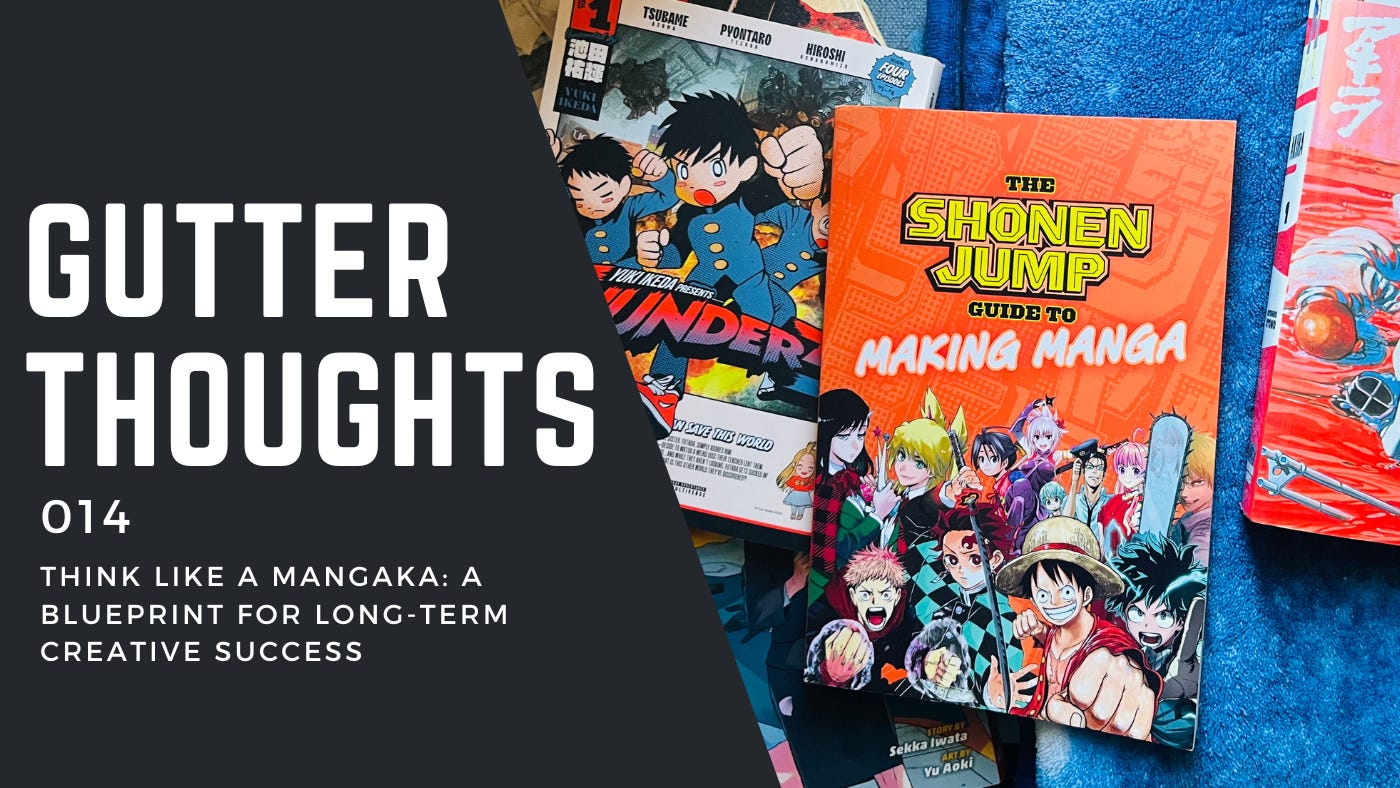Gutter Thoughts 014: Think Like a Mangaka! A Blueprint for Long-Term Creative Success
The Secret to Longevity in Comics
Welcome to Gutter Thoughts, where I share insights into my creative process and philosophy each week. From exploring big ideas to finding inspiration in comics, books, shows, and movies, this space is all about staying creative and grounded.
Weekly Creative Focus
Whether diving into creative work or spending time learning and reflecting, here’s what’s been on the mind and plate this week.
Think Like a Mangaka: A Blueprint for Long-Term Creative Success
The Secret to Longevity in Comics
Most aspiring comic creators dream of crafting an epic, long-running series. But few actually make it past their first few chapters. Why? Because they burn out before they even hit their stride.
Meanwhile, manga creators (mangaka) churn out weekly chapters for years—sometimes decades—without losing momentum. How? They’ve mastered a streamlined approach that allows them to create consistently without sacrificing quality.
If you want to build a long-term creative practice, you need a system that works with you, not against you.
Here’s how to think like a mangaka and set yourself up for success.
1. Keep Your Creative Process as Simple as Possible
Manga is typically created by a single person. Sometimes, a mangaka works with a co-writer or a small team of assistants, but at its core, the process is a solo endeavor. With relentless deadlines, they must keep their workflow efficient.
By following the mangaka mindset, you can simplify your process and produce work more consistently. Here’s how:
1. Plan your pages quickly and loosely. Get your ideas down on paper (or in digital notes) as fast as possible. Refinement comes later.
2. Keep your art black and white. This allows you to control detail levels more easily and finish pages faster.
3. Stick to a simple grid system. While Western comics often push dynamic panel layouts, many top manga rely on straightforward grids that prioritize readability.
By simplifying your creative process, you’ll gain two major advantages:
1. Faster project completion.
2. Quicker feedback, allowing for adjustments and growth.
One of the best lessons I learned while working as a writer for Apple was a reminder plastered across the marketing team’s building: Simplify. Simplify. Simplify.
2. Master the Art of Creating Memorable Characters
If your characters aren’t compelling, readers won’t stay for the story. Characters are the driving force that pulls audiences into your world.
Hirohiko Araki, creator of JoJo’s Bizarre Adventure, puts it best in Manga in Theory and Practice:
“If you have an effective character in place, you will be undefeatable. Taken to the extreme, this means that compelling characters negate the need for story or setting. That’s how incredibly important they are.”
One of Araki’s secret ingredients for strong character development is character histories—a deep dive into a character’s background that influences their personality, decisions, and presence on the page.
Before you start drawing, take time to flesh out details. Nothing is off-limits:
• What’s their favorite TV show?
• Do they have any tattoos? If so, why did they get them?
• What’s a childhood memory that shaped them?
This is a practice I use for every character I create. It’s an ongoing process—whenever I discover something new about them, I add it to their file.
In 2019, I got a tattoo from one of my favorite manga. I didn’t choose a scene from the story—I chose a character. The plot was solid (a 7.5/10 for me), but it was the characters that kept pulling me back. They made the world feel alive.
Your characters should do the same.
3. Create and Share One-Shot Projects
A one-shot is a short, self-contained comic—ranging anywhere from 2 to 50 pages—with a clear resolution (or an open ending that still feels satisfying).
The Shonen Jump Guide to Making Manga encourages new creators to start with one-shots before diving into long-form stories. Here’s why:
• You’ll complete projects faster.
• You’ll get feedback sooner.
• Publishers and readers can quickly assess your storytelling skills.
Many legendary manga began as one-shots:
• One Piece started as Wanted!, a short standalone story.
• Chainsaw Man creator Tatsuki Fujimoto drew multiple one-shots before his breakout series—one of which was even adapted into an anime movie.
A lot of aspiring creators want to jump straight into a full-length series. But what if your story doesn’t connect? What if you realize midway that you don’t enjoy telling it? A one-shot lets you test ideas and refine your storytelling before committing to a long-term project.
Bringing It All Together
If I could go back and redo Boom Kid from the beginning, these are the exact steps I would follow. They would have saved me from burnout and helped me finish faster. But I’m okay with that—because now, moving forward, I will be applying them.
And you should too.
By simplifying your process, developing deeper characters, and starting with one-shots, you’ll set yourself up for long-term creative success. Whether you’re crafting manga, webcomics, or indie graphic novels, this blueprint will help you create better work, faster.
This Week’s Creative Sparks
Here are the shows, books, movies, comics, and more that have sparked my creativity this week:
Book Spark: Chain Gang All-Stars by Nana Kwame Adjei-Brenyah
I’ve been hearing about this book for the past year—a future where prisoners fight for their freedom. Sign me up. I worried it might lean too much into familiar tropes, but on the last day of Black History Month, I finally gave it a shot, and oohhh, I’m so glad I did. Only two chapters in, and I’m already hooked. Not only is it delivering on its premise, but it’s also packed with interesting characters and deep world-building. I can already tell I’m going to tear through this one and still want more.

Music Spark: Life is Beautiful by Larry June, 2 Chainz, The Alchemist
I saw that three artists I’ve been vibing with a lot lately dropped a new track, so I clicked to check it out. Turns out, it wasn’t just a single—it was a whole album, and man, I loved it. Waking up on a Sunday morning and hearing these melodies was a vibe. It’s been a long time since I’ve played an album from start to finish, but this one had me locked in. Whenever I need a reminder that, despite everything, life is beautiful, I throw this record on.
The Stoic Quote of the Week
A Stoic quote to inspire and motivate, helping to stay grounded in the creative process.
“Above all, it is necessary for a person to have a true self-estimate, for we commonly think we can do more than we really can.”
—Seneca , On Tranquility of Mind
This quote hit me hard this week. It’s a reminder that being honest with ourselves is everything. We need to take stock of our skills, desires, and goals—what can we actually accomplish? How much can we really handle? And most importantly, we have to stop comparing ourselves to others, especially those who are five or ten steps ahead. Learning from them is great, but our focus should be on what we can do right now—consistently. Only when we get real with ourselves can we take the right steps toward success.
That’s a wrap for this week’s Gutter Thoughts. Thanks for joining me on this creative journey—hopefully, something here sparked an idea or inspired your own work. Until next time, stay grounded, stay creative, and keep pushing forward.
Let’s Connect
Enjoying Gutter Thoughts?
Imagine having emails like this crafted specifically for your brand or business. Whether you’re a creative storyteller or a brand strategist, I’ll help you turn your unique voice and ideas into engaging, value-packed content.
Ready to level up your email game? Let’s talk about how we can co-create emails that captivate your audience and drive real results.
Note: This post contains affiliate links. I earn a small commission if you purchase through these links at no extra cost to you. I only recommend products I personally use and love.



